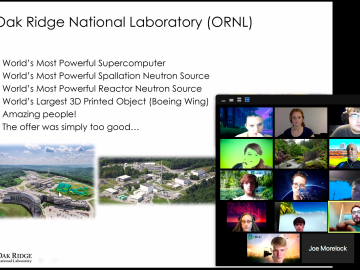
Filter News
Area of Research
- Biology and Environment (9)
- Clean Energy (46)
- Climate and Environmental Systems (1)
- Fusion and Fission (4)
- Fusion Energy (2)
- Isotopes (3)
- Materials (29)
- Materials for Computing (1)
- National Security (5)
- Neutron Science (15)
- Nuclear Science and Technology (15)
- Quantum information Science (2)
- Sensors and Controls (1)
- Supercomputing (24)
News Type
News Topics
- 3-D Printing/Advanced Manufacturing (11)
- Advanced Reactors (4)
- Artificial Intelligence (5)
- Big Data (6)
- Bioenergy (6)
- Biology (3)
- Biomedical (11)
- Biotechnology (1)
- Chemical Sciences (2)
- Clean Water (2)
- Climate Change (1)
- Composites (1)
- Computer Science (22)
- Coronavirus (11)
- Cybersecurity (4)
- Energy Storage (8)
- Environment (8)
- Exascale Computing (2)
- Fusion (10)
- Grid (5)
- High-Performance Computing (1)
- Isotopes (6)
- Machine Learning (2)
- Materials Science (13)
- Mathematics (2)
- Mercury (1)
- Microscopy (4)
- Molten Salt (1)
- Nanotechnology (4)
- Neutron Science (9)
- Nuclear Energy (19)
- Physics (9)
- Polymers (3)
- Quantum Science (6)
- Security (4)
- Space Exploration (2)
- Summit (7)
- Sustainable Energy (4)
- Transformational Challenge Reactor (3)
- Transportation (8)
Media Contacts

Each summer for the last 30 years, students and teachers from across Appalachia have travelled to ORNL for a unique STEM summer camp experience – the Appalachian Regional Commission/ORNL Science-Technology-Mathematics Institute.

Joe Hagerman, ORNL research lead for buildings integration and controls, understands the impact building technology innovations can have during times of crisis. Over a decade ago, he found himself in the middle of one of the most devastating natural disasters of the century, Hurricane Katrina.

Scientists seeking ways to improve a battery’s ability to hold a charge longer, using advanced materials that are safe, stable and efficient, have determined that the materials themselves are only part of the solution.

The 75th anniversary of the final voyage of the USS Indianapolis and her brave crew is Thursday, July 30. The US Navy warship was on a top-secret mission across the Pacific Ocean to deliver war materials that marked the conclusion of the Manhattan Project.

ORNL researchers have developed an intelligent power electronic inverter platform that can connect locally sited energy resources such as solar panels, energy storage and electric vehicles and smoothly interact with the utility power grid.

Lithium, the silvery metal that powers smart phones and helps treat bipolar disorders, could also play a significant role in the worldwide effort to harvest on Earth the safe, clean and virtually limitless fusion energy that powers the sun and stars.

From materials science and earth system modeling to quantum information science and cybersecurity, experts in many fields run simulations and conduct experiments to collect the abundance of data necessary for scientific progress.

Ada Sedova’s journey to Oak Ridge National Laboratory has taken her on the path from pre-med studies in college to an accelerated graduate career in mathematics and biophysics and now to the intersection of computational science and biology

In the search to create materials that can withstand extreme radiation, Yanwen Zhang, a researcher at the Department of Energy’s Oak Ridge National Laboratory, says that materials scientists must think outside the box.

COVID-19 has upended nearly every aspect of our daily lives and forced us all to rethink how we can continue our work in a more physically isolated world.


